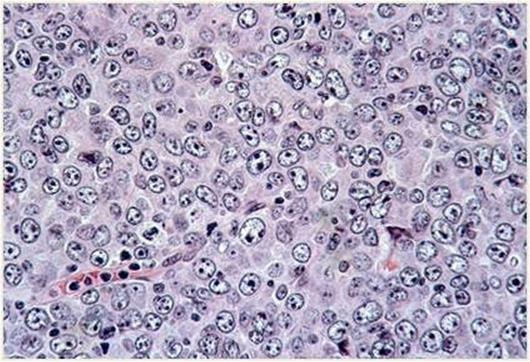
Despite improvements in outcome in diffuse large B-cell lymphoma (DLBCL) in the monoclonal antibody rituximab treatment era, central nervous system (CNS) relapse continues to occur and typically is incurable. Identifying high-risk patients is essential to focus on effective prophylaxis strategies. To date, there have not been any identified robust biomarkers to predict those at high risk. Previous seminal studies from the BC Cancer Agency have identified MYC and BCL2 dual expression to be associated with poor outcome. Importantly, a study published in Blood (May 2016) by a TFRI-funded team suggests that dual expression of MYC and BCL2 tested by immunohistochemistry (IHC) is associated with an increased risk of CNS relapse.
DLBCL is the most common type of non-Hodgkin lymphoma (NHL), comprising around 30 to 40 % of all cases. Initial chemotherapy treatments are often successful in more than half of patients, but many patients still relapse. Dual translocation of MYC and BCL2, also known as “double-hit lymphoma,” has been associated with a high risk of central nervous system (CNS) relapse, yet the impact of dual expression of MYC and BCL2 (dual expressers) on the risk of CNS relapse remains unknown.
In the present study, 428 patient biopsies from newly diagnosed DLBCL treated with curative-intent rituximab plus cyclophosphamide, doxorubicin, vincristine, and prednisone (R-CHOP) were collated from existing tissue microarrays and were evaluated for MYC and BCL2 dual protein expression by IHC. The cumulative risk of CNS relapse was higher in dual expressors and defined a high-risk group with the non-GCB/ABC DLBCL subtype (~16% vs ~3%, P=.01). Further, MYCBL2 dual expression remained a significant variable in multivariate analyses, in addition to the recently described CNS risk model (CNS-IPI (international prognostic index) where those patients with a high CNS-IPI risk score and dual expression of MYC and BCL2 had a CNS relapse risk of ~23%.
These results have immediate and direct clinical implications, as patients in this category can be screened with CNS-directed staging studies and strongly considered for CNS prophylaxis strategies. Further studies are ongoing to define additional biomarkers and genetic factors that can help refine the identification of a high-risk CNS relapse group to focus aggressive CNS-directed staging procedures and select patients for prophylactic strategies.
Study: Impact of dual expression of MYC and BCL2 by immunohistochemistry on the risk of CNS relapse in DLBCL
Authors: Kerry J. Savage, Graham W. Slack, Anja Mottok, Laurie H. Sehn, Diego Villa, Roopesh Kansara, Robert Kridel, Christian Steidl, Daisuke Ennishi, King L. Tan, Susana Ben-Neriah, Nathalie A. Johnson, Joseph M. Connors, Pedro Farinha, David W. Scott, and Randy D. Gascoyne.
Funding: This work was supported by a Program Project Grant No. 1023 from the Terry Fox Research Institute, and by grants from the Canadian Institutes of Health Research and the British Columbia Cancer Foundation.
TFRI Links, Fall 2016